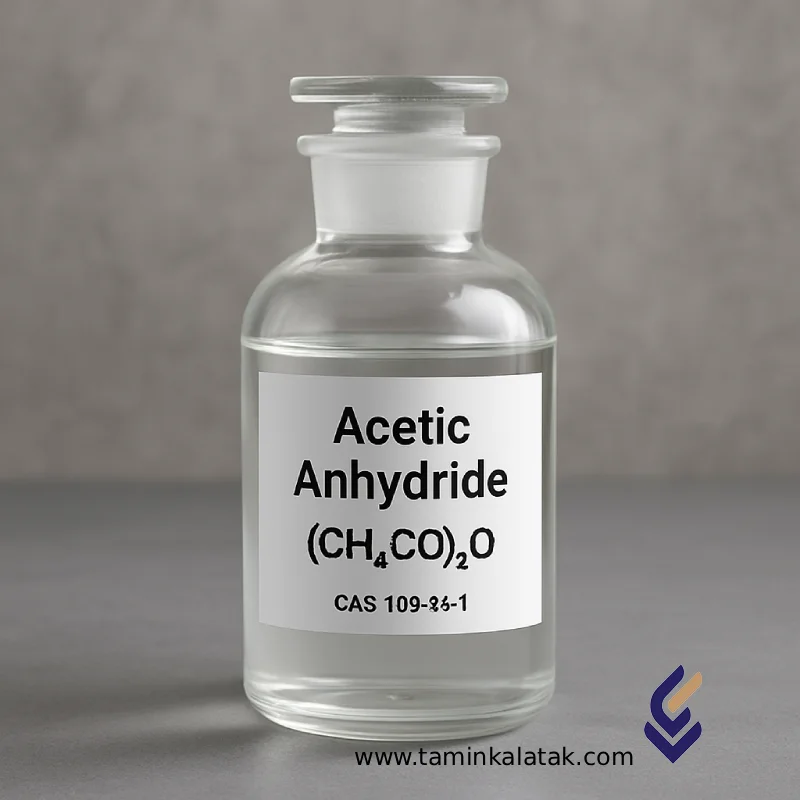Acetic anhydride
Acetic anhydride is a simple and highly reactive acid anhydride, appearing as a colorless liquid with a strong, vinegar-like odor.
It plays a key role in industrial acetylation reactions and serves as a vital intermediate in the manufacture of cellulose acetate (used in cigarette filters), pharmaceuticals (notably aspirin and paracetamol), resins, solvents, and industrial explosives.
Because of its broad utility, acetic anhydride remains one of the most widely traded and regulated chemical intermediates globally.
Chemical Structure
-
Structural Formula: (CH₃CO)₂O
-
Molecular Description: Two acetyl groups linked through a central oxygen atom, forming a simple carboxylic acid anhydride.
Physical and Chemical Properties
| Property | Specification |
|---|---|
| Appearance | Clear, colorless liquid with a strong, pungent odor |
| Density (20 °C) | ~1.082 g/cm³ |
| Melting Point | −73 °C |
| Boiling Point | 139–140 °C |
| Vapor Pressure (36 °C) | ~10 mmHg |
| Refractive Index (nD, 20 °C) | ~1.390 |
| Solubility in Water | Reacts rapidly (hydrolyzes exothermically); ~2.6% soluble at 20 °C |
| Flash Point (Closed Cup) | 54 °C (129 °F) |
| Explosion Limits (air) | 2.0–10.2 vol% |
| Oral Toxicity (LD₅₀, rat) | ~1.78 g/kg |
Advantages
-
Primary acetylation agent in the synthesis of aspirin and paracetamol
-
Essential in producing cellulose acetate for filters, plastic films, and fibers
-
Widely used in resin, pharmaceutical, fragrance, and dye production
-
Intermediate for modified starches (E1414, E1420, E1422) in food and pharma industries
-
Functions as an efficient dehydrating and acetylating agent in chemical processes
Limitations and Hazards
-
Highly reactive with water and alcohols; hydrolyzes exothermically
-
Corrosive to skin, eyes, and mucous membranes — causes severe burns on contact or inhalation
-
Flammable and reactive with metals; requires specialized storage and transport
-
Strictly regulated precursor (U.S. DEA List II chemical) due to potential illicit use in heroin synthesis
Applications
-
Pharmaceuticals: Acetylation of salicylic acid to produce aspirin
-
Plastics & Fibers: Manufacture of cellulose acetate for films, textiles, and cigarette filters
-
Resins & Coatings: Intermediate for resins, dyes, and fragrance chemicals
-
Food Industry: Used in modified starch production (E1414–E1422)
-
Industrial Chemicals: Effective dehydrating agent in various syntheses
Safety and Regulatory Information
-
GHS Label: ⚠️ DANGER
-
Hazard Statements:
-
H226 – Flammable liquid and vapor
-
H302 – Harmful if swallowed
-
H314 – Causes severe skin burns and eye damage
-
H330 – Fatal if inhaled
-
-
Recommended PPE:
-
Chemical-resistant protective clothing
-
Safety goggles or full face shield
-
Nitrile or Viton® gloves
-
Approved respirator (limit ≤ 5 ppm per ACGIH TLV/OSHA PEL)
-
Storage and Handling
-
Store in a cool, dry, well-ventilated area, away from moisture, open flames, and strong acids
-
Use airtight, corrosion-resistant containers clearly labeled and tightly sealed
-
Avoid contact with water or incompatible materials
-
In case of leak or spill: absorb with dry inert material; keep away from ignition sources
-
Firefighting media: CO₂, dry chemical, or alcohol-resistant foam
Summary
Acetic Anhydride is an indispensable reagent in acetylation chemistry with broad industrial use in pharmaceuticals, cellulose derivatives, and coatings.
Its high reactivity and strict regulatory classification demand careful handling and storage, but its efficiency and versatility make it a cornerstone compound in organic synthesis.
Applications
| Applications | , , , , |
|---|
Acetic anhydride
| Products | Chemical formula | Solubility in water | CAS number | Grade | Vapor pressure | Physical appearance | Density (at 20°C) | Melting point |
|---|---|---|---|---|---|---|---|---|
| Acetic Anhydride | C₄H₆O₃ یا (CH₃CO)₂O | Reactive – hydrolyzes rapidly (≈2.6% at 20 °C) | 108-24-7 | Industrial Grade, Laboratory Grade (Reagent Grade, ≥99%), Pharmaceutical Grade (Pharma Grade – under special control) | About 4–5 mmHg (at 36 °C: ≈10 mmHg) | Clear, colorless liquid with a pungent, vinegar-like odor. | 1.082 g/cm³ | −73 °C |







